Human Orbital Spaceflights
![]()
International Flight No. 116Soyuz TM-5Soyuz TM-4RodnikUSSR |
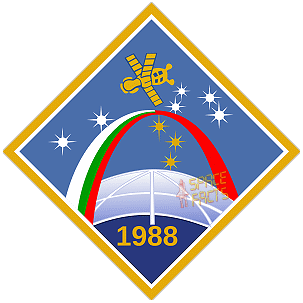 |
![]()
Launch, orbit and landing data
walkout photo |
 |
|||||||||||||||||||||||||||||||
alternative crew photo |
alternative crew photo |
|||||||||||||||||||||||||||||||
alternative crew photo |
alternative crew photo |
|||||||||||||||||||||||||||||||
alternative crew photo |
alternative crew photo |
|||||||||||||||||||||||||||||||
Crew
| No. | Surname | Given names | Position | Flight No. | Duration | Orbits | |
| 1 | Soloviyov | Anatoli Yakovlevich | Commander | 1 | 9d 20h 09m 19s | 156 | |
| 2 | Savinykh | Viktor Petrovich | Flight Engineer | 3 | 9d 20h 09m 19s | 156 | |
| 3 | Aleksandrov | Aleksandr Panayatov "Sasha" | Research Cosmonaut | 1 | 9d 20h 09m 19s | 156 |
Crew seating arrangement
|
 |
|
||||||||||||||||
Backup Crew
|
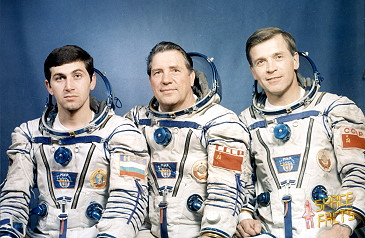 |
||||||||||||||||||||
alternative crew photo |
|||||||||||||||||||||
alternative crew photo |
|||||||||||||||||||||
alternative crew photo |
Hardware
| Launch vehicle: | Soyuz-U2 (No. Ye15000-027) |
| Spacecraft: | Soyuz TM-5 (7K-STM No. 55) |
Flight
|
Launch from the Baikonur Cosmodrome and
landing with Soyuz TM-4 156 km
southeast of Dzheskasgan. Aleksandr
Aleksandrov became the second cosmonaut from
Bulgaria. Following a two-day solo flight Soyuz TM-5 docked with the Mir-Kvant-Soyuz TM-4 complex to Mir's aft port on June 09, 1988. The crew conducted joint scientific work with the third resident crew. Due to the Soyuz 33 failure, Bulgaria was the only East European Soviet ally not to have had a citizen visit a Soviet space station. Bulgarian Research Cosmonaut Aleksandr Aleksandrov used nearly 2,000 kg of equipment delivered by Progress freighters to conduct 46 experiments in the Shipka program during his stay. 46 scientific experiments were performed, including astrophysical and astronomical research using the Rozhen astronomical experiment, Earth observation (coast of the Black Sea region), materials sciences, medicine and biology. Photos and spectral analysis were taken from the Bulgarian territory, standard, when foreign cosmonauts are on-board the Mir. They also worked with the Kristallisator experiment. On September 05, 1988 cosmonauts Vladimir Lyakhov and Abdulahad Momand undocked from Mir. They jettisoned the orbital module and made ready for deorbit burn to return to Earth. During descent, the spacecraft experienced a computer software problem combined with a sensor problem. This caused their landing to be delayed by a full day. The descent module, where they spent this 24-hour period, had no sanitary facilities. They would not have been able to redock with Mir because they had discarded the docking system along with the orbital module. Reentry occurred as normal on September 07, 1988. Following this incident, the Soviets decided that on future missions, they would retain the orbital module until after deorbit burn, as they had done on the Soyuz ferry flights The Soyuz spacecraft is composed of three elements attached end-to-end - the Orbital Module, the Descent Module and the Instrumentation/Propulsion Module. The crew occupied the central element, the Descent Module. The other two modules are jettisoned prior to re-entry. They burn up in the atmosphere, so only the Descent Module returned to Earth. The deorbit burn lasted about 240 seconds. Having shed two-thirds of its mass, the Soyuz reached Entry Interface - a point 400,000 feet (121.9 kilometers) above the Earth, where friction due to the thickening atmosphere began to heat its outer surfaces. With only 23 minutes left before it lands on the grassy plains of central Asia, attention in the module turned to slowing its rate of descent. Eight minutes later, the spacecraft was streaking through the sky at a rate of 755 feet (230 meters) per second. Before it touched down, its speed slowed to only 5 feet (1.5 meter) per second, and it lands at an even lower speed than that. Several onboard features ensure that the vehicle and crew land safely and in relative comfort. Four parachutes, deployed 15 minutes before landing, dramatically slowed the vehicle's rate of descent. Two pilot parachutes were the first to be released, and a drogue chute attached to the second one followed immediately after. The drogue, measuring 24 square meters (258 square feet) in area, slowed the rate of descent from 755 feet (230 meters) per second to 262 feet (80 meters) per second. The main parachute was the last to emerge. It is the largest chute, with a surface area of 10,764 square feet (1,000 square meters). Its harnesses shifted the vehicle's attitude to a 30-degree angle relative to the ground, dissipating heat, and then shifted it again to a straight vertical descent prior to landing. The main chute slowed the Soyuz to a descent rate of only 24 feet (7.3 meters) per second, which is still too fast for a comfortable landing. One second before touchdown, two sets of three small engines on the bottom of the vehicle fired, slowing the vehicle to soften the landing. |
Relocations of Manned Spacecrafts
| Spacecraft | from | Undocking | Time UTC | to | Redocking | Time UTC |
| Soyuz TM-5 | Mir - Kvant | 18.06.1988 | 10:11:00 | Mir - Baseblock | 18.06.1988 | 10:27:01 |
Photos / Graphics
 |
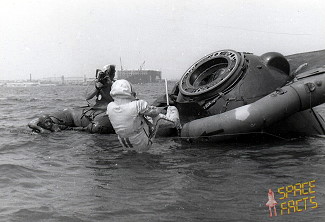 |
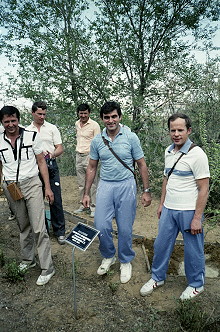
Credit: GTCT |
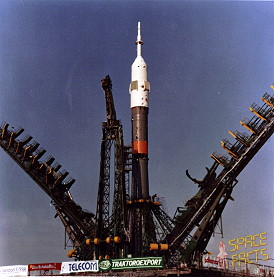 |
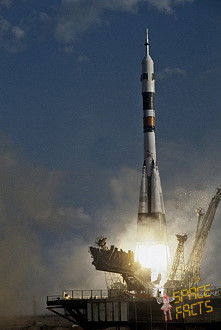 |
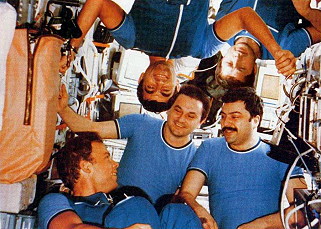 |
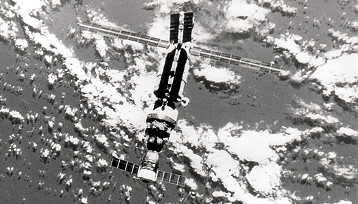 |
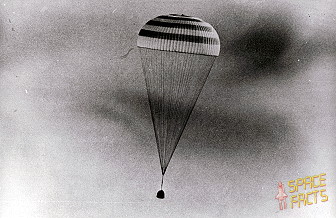 |
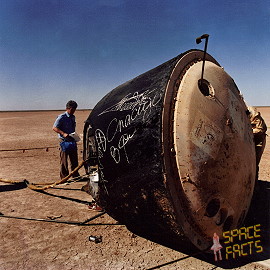 |
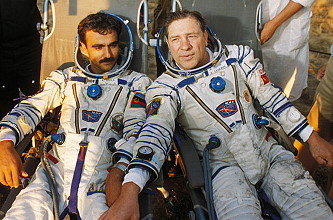 |
| © |  |
Last update on May 16, 2021.  |
 |